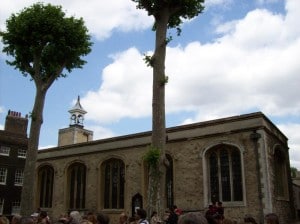
On this day in history, 23rd February 1554, Henry Grey, Duke of Suffolk, was executed on Tower Hill following his involvement in the failed rebellion against Mary I – Wyatt’s Rebellion – and his attempt to flee the country. Suffolk’s daughter and son-in-law, Lady Jane Grey and Lord Guildford Dudley, had been executed eleven days earlier.
Here is an extract from my book On This Day in Tudor History about Suffolk’s execution:
“He was escorted to Tower Hill at 9am on 23rd February and, according to John Foxe’s account, as he climbed the scaffold Mary I’s Chaplain, Hugh Weston, attempted to follow him. Suffolk pushed him back down the stairs and a scuffle ensued, but Weston told Suffolk that it was the Queen’s orders that he speak to the crowd. Weston went ahead and preached a sermon attacking Suffolk’s Protestant beliefs. Suffolk then addressed the crowd, saying:
Masters, I have offended the queen and her laws, and thereby am justly condemned to die, and am willing to die, desiring all men to be obedient. And I pray God that this my death may be an en-sample to all men, beseeching you all to bear me witness, that I die in the faith of Christ, trusting to be saved by his blood only, and by no other trumpery, the which died for me, and for all them that truly repent, and stedfastly trust in him. And I do repent, desiring you all to pray to God for me; and that when you see my breath depart from me, you will pray to God that he may receive my soul.
Then he asked for forgiveness and knelt down, holding up his hands and looking up to heaven, saying the psalm, Miserere mei Deus. He ended by saying “In manes tuus, Domine, commendo spiritum meum” (Into thy hands, O Lord, I commend my spirit) and then stood up, took off his cap and scarf, and gave them to the executioner. The executioner asked for Suffolk’s forgiveness, but the proceedings were interrupted by a member of the crowd, a man who was owed money by Suffolk, asking how he should go about getting the money. Suffolk replied, “Alas, good fellow! I pray thee trouble me not now; but go thy way to my officers.” Then he tied a handkerchief over his eyes and knelt down once more, praying the Lord’s Prayer followed by the words “Christ have mercy upon me”. He laid his head on the block and his head was struck off with one blow. His remains were buried in the chancel area of St Peter ad Vincula, the Tower chapel.”
Notes and Sources
- On This Day in Tudor History, 2012, Claire Ridgway
- The Acts and Monuments of John Foxe: a New and Complete Edition with a Preliminary Dissertation by Rev. George Townsend, 1838, p545